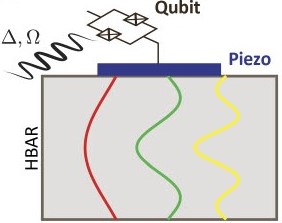Research Interests
We theoretically investigate quantum behavior of light, mechanical, and generally bosonic systems. The goal is to bring such systems into interaction with electronic and spin states of the matter and build-up hybrid quantum systems. Such hybrid systems are beneficial in exploration of quantum foundation and can be employed in quantum technologies, such as quantum sensors and quantum communications.
Quantum Optomechanics
 From the beginning of the millennium, ability in fabrication of nanomechanical systems from one hand and tremendous progress in control and assembly of micro and nano sized cavities, on the other hand, has brought the scientist inevitably to their hybridization. Giving birth to the field of quantum optomechanics. Such systems have so far attained many successes regarding quantum mechanical behaviors in light–mechanics. From the ground state cooling of macroscopic mirrors to microwave–mechanical entanglement. Yet, there are many fields to be explored.
From the beginning of the millennium, ability in fabrication of nanomechanical systems from one hand and tremendous progress in control and assembly of micro and nano sized cavities, on the other hand, has brought the scientist inevitably to their hybridization. Giving birth to the field of quantum optomechanics. Such systems have so far attained many successes regarding quantum mechanical behaviors in light–mechanics. From the ground state cooling of macroscopic mirrors to microwave–mechanical entanglement. Yet, there are many fields to be explored.One of our goals in the theoretical quantum optics group is to propose and provide recipe for employing novel opto-, electro-, and spin-mechanical systems in exploration of foundational quantum theories.
Related publications:
-
M. Abdi, Phys. Rev. A 103, 043520 (2021).
-
M. Abdi, Phys. Rev. B 100, 184310 (2019).
-
M. Abdi and M.B. Plenio, Phys. Rev. Lett. 122, 023602 (2019).
Color centers
 Wide band gap solids like diamond are transparent in their pristine form. However, some point defects can introduce inter-band-gap energy levels that can support narrow frequency optical transitions and emit light quanta, hence the color centers. Such emitters have recently been observed in layered hexagonal boron nitride (hBN) material. The emissions from hBN membranes are not fully understood, yet.
Wide band gap solids like diamond are transparent in their pristine form. However, some point defects can introduce inter-band-gap energy levels that can support narrow frequency optical transitions and emit light quanta, hence the color centers. Such emitters have recently been observed in layered hexagonal boron nitride (hBN) material. The emissions from hBN membranes are not fully understood, yet.Hence, one of our ongoing projects is studying the origins of these emissions by means of ab initio computations and group theory analysis. We then propose systems that exploit the electronic and spin properties of the emitters in quantum technology.
Related publications:
- Q. Hassanzada, I. Abdolhosseini Sarsari, A. Hashemi, A. Ghojavand, A. Gali, and M. Abdi, Phys. Rev. B 102, 134103 (2020).
- S. Li, J.-P. Chou, A. Hu, M.B. Plenio, P. Udvarhelyi, G. Thiering, M. Abdi, and A. Gali, npj Quantum Information 6, 85 (2020).
-
M. Abdi, J.-P. Chou, A. Gali, and M.B. Plenio, ACS Photonics 5, 1967 (2018).
Continuous Variables
 Secure quantum communication, quantum simulation, and quantum computation are the quantum theory gifts that have to be fully exploited. There are various strategies on this way. They can be basically divided into discrete variable (finite Hilbert space dimension) and continuous variable (infinite Hilbert space dimension) methods. Each of which possess their advantages and disadvantages. This have brought physicist to a third strategy; the hybrid DV–CV approach.
Secure quantum communication, quantum simulation, and quantum computation are the quantum theory gifts that have to be fully exploited. There are various strategies on this way. They can be basically divided into discrete variable (finite Hilbert space dimension) and continuous variable (infinite Hilbert space dimension) methods. Each of which possess their advantages and disadvantages. This have brought physicist to a third strategy; the hybrid DV–CV approach.In our group, we are working on DV, CV, and hybrid quantum information processing systems and protocols from quantum repeaters to quantum simulators.
Related Publications:
- Y. Mardani, A. Shafiei, M. Ghadimi, and M. Abdi, Phys. Rev. A 102, 012407 (2020).
- M. Abdi, S. Pirandola, P. Tombesi, and D. Vitali, Phys. Rev. Lett. 109, 143601 (2012).
